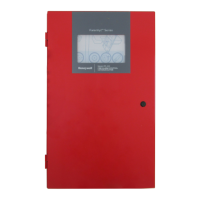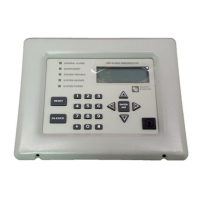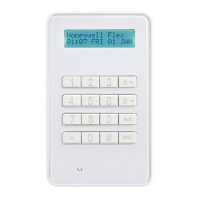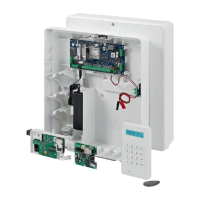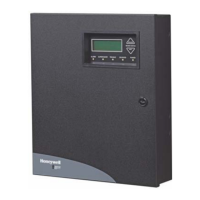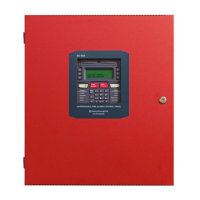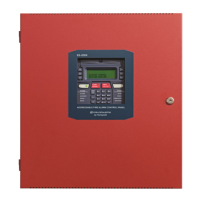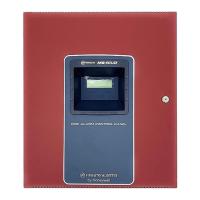120 IFP-75 Series Manual — P/N LS10147-001SK-E:E 4/6/2022
Section 11: Testing and Troubleshooting
11.1 Troubleshooting
This section of the manual offers suggestions for troubleshooting hardware problems. Please read this section if you encounter a problem
when you install the fire alarm control panel. If these suggestions do not solve your problem or if you encounter a problem that is not listed,
contact Honeywell technical support for assistance.
11.2 Troubleshooting Common Problems
11.2.1 Periodic Testing And Maintenance
To ensure proper and reliable operation, it is recommended that the System inspection and testing be scheduled monthly or as required by the
national and/or local fire codes. Testing should be done by a qualified services representative if a malfunction is encountered.
Before testing:
1. Notify the fire department and/or the Central Alarm Receiving Station if an alarm condition is transmitted.
2. Notify the facility personnel of a test so that the alarm sounding devices are ignored during the test period.
3. When necessary, activation of notification appliances can be prevented by the DISABLE function.
Testing:
1. Activate an input via an alarm initiating device and check that the correct outputs activate (notification appliances sound/flash, relays
activate, alarm LED lights). Reset the system. Repeat for each alarm initiating device.
2. Momentarily open the following circuits one at a time and check for a trouble signal:
• notification appliance (bell) circuits
• initiating devices
3. If new batteries were installed, wait 48 hours before completing this step. Remove the AC power, activate the initiating device, and
check that the following occurs:
• The ALARM indicator lights.
• All active notification appliances sound.
Problem Possible Cause / Suggested Actions
Trouble message “DBL ADDR” (Double
Address) displays on LCD.
An address has been assigned to more than one detector. Check detector addresses for duplications.
For information on setting the SLC address, refer to the SLC Wiring Manual.
Auxiliary power or notification circuits
have incorrect polarity.
Correct polarity. For notification and auxiliary power circuits, terminals labeled “X” are positive, terminals
labeled “O” are negative.
SLC devices are not being recognized
(trouble message “Missing” displays).
Check hardware connections. If devices are physically connected, make sure the wiring is correct.
For more information on SLC wiring, refer to the SLC Wiring Manual.
For the main panel, the positive side of the device must be connected to Terminal 34; the negative side must
be connected to Terminal 33. For SLC devices, make sure the device connects to the SLC loop via the SLC
OUT terminals.
Make sure SLC devices have been addressed properly.
For information on the procedure to set the SLC Devices addresses, refer to the SLC Wiring Manual.
For contact monitor modules, which are addressed using DIP switches, the DIP switch must be set to the
correct address before power is applied to the SLC loop. If this procedure is not followed, the device will have
an incorrect address.
Make sure the correct polarity has been observed for SLC device wiring.
For more information on SLC devices, refer to the SLC Wiring Manual.
SLC devices are not being recognized
(trouble message “Missing” displays on
the annunciator).
Check that SLC loop impedance is within the required range.
To measure impedance, use the following procedure.
Disconnect both wires from the terminal block at the panel (SLC devices can remain connected).
Measure the impedance from positive to negative and from negative to positive. Both measurements should
be greater than 500 K ohms. If the installation uses T-taps, test each T-tap individually.
Temporarily connect the positive wire to the negative wire of the SLC loop at the point farthest from the panel
(SLC devices can remain connected).
Measure the impedance from positive to negative and from negative to positive. Both measurements must be
less than 50 ohms.
5496 module that has been physically
connected to the panel but is not being
recognized.
Check the status of the 5496 green LED. If this LED flashes in a 0.5 sec. on / 0.5 sec. off pattern, it is likely
that the 5496 has not been added to the system through programming. JumpStart will add any 5496 modules
connected to the panel. If you have already run JumpStart, 5496 modules can be added manually (see
Section 8.2.2).
Check that the correct ID for the 5496 module has been set through the DIP switches. Assign ID#1 to the first
5496 and ID#2 to the second 5496. See Section 4.13.1 for complete details.
If the wiring between the 5496 and the panel is correct, measure the voltage from 5496 Terminal (+) to
Terminal (-). Voltage should be in the range 27.2-27.4V when AC power is present.
If the green LED is not flashing, the likely cause is incorrect wiring from between the 5496 and the panel. See
Section 4.6.3 for wiring details.
Table 11.1 Troubleshooting Chart

